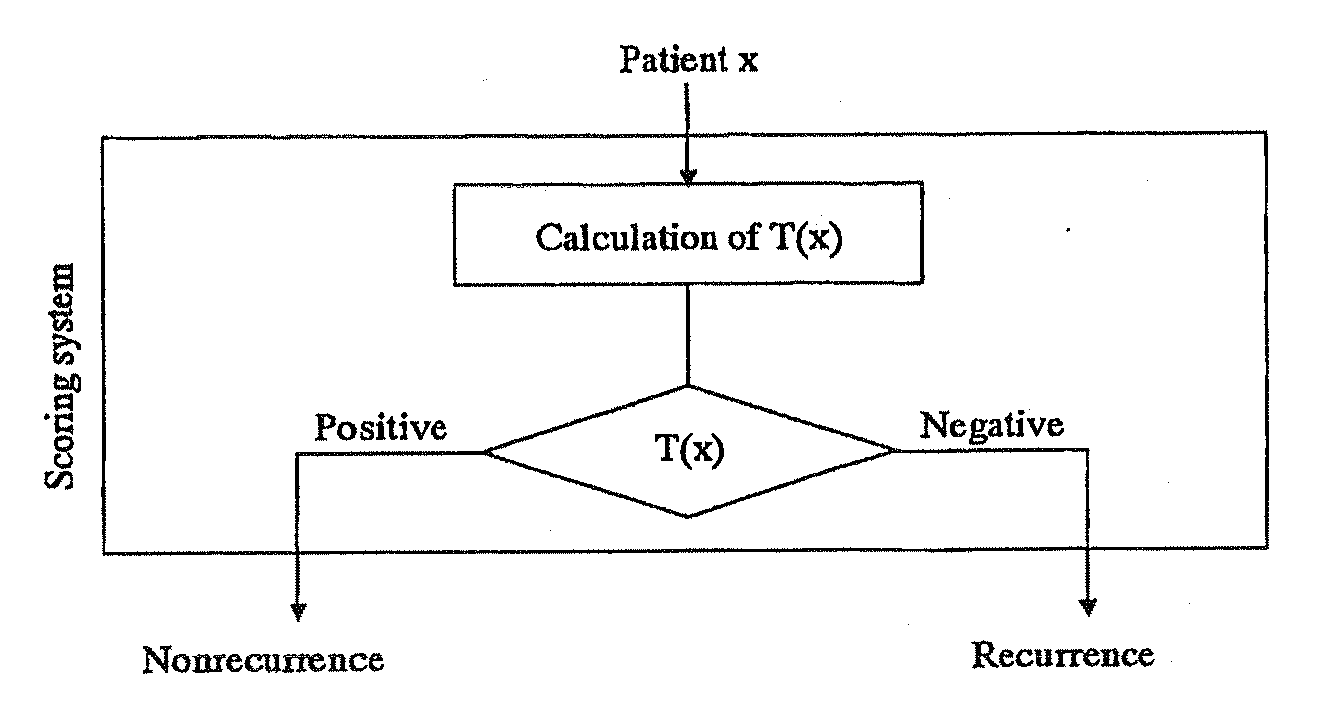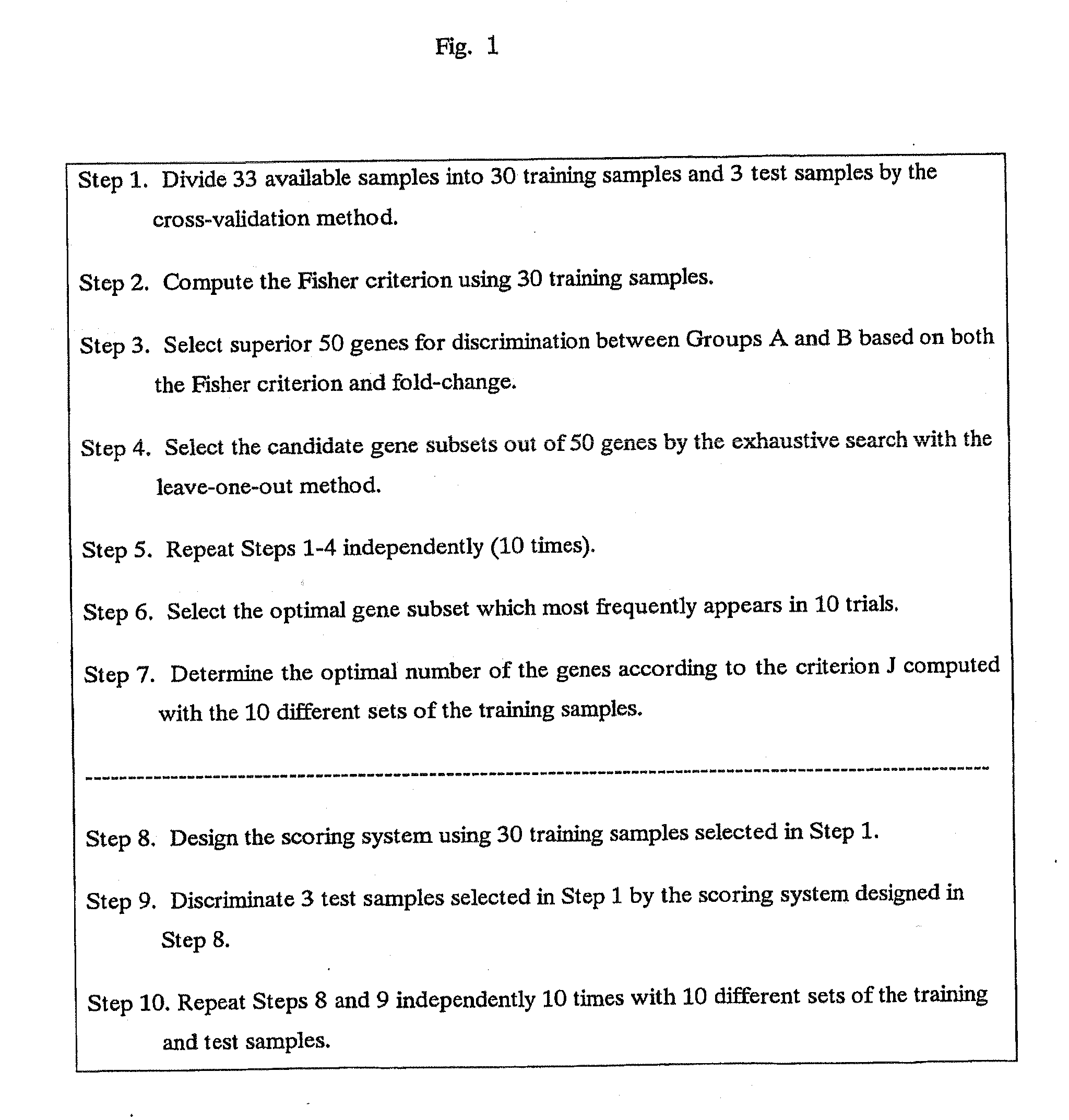Scoring system for the prediction of cancer recurrence
a scoring system and cancer technology, applied in the field of scoring system for the prediction of cancer recurrence, can solve the problems of intrahepatic metastasis, no promising treatment for cancer, and cancer is a dreaded diseas
- Summary
- Abstract
- Description
- Claims
- Application Information
AI Technical Summary
Benefits of technology
Problems solved by technology
Method used
Image
Examples
example 1
Selection of the Patients for Analysis of Early Intrahepatic Recurrence
[0024]It has been reported that early intrahepatic recurrences (within one year) after surgery arise mainly from intrahepatic metastases, whereas late recurrences are more likely to be multicentric occurrence (Poon, R. T. et al. Different risk factors and prognosis for early and late intrahepatic recurrence after resection of hepatocellular carcinoma, Cancer 89, 500-507 (2000)). Moreover, it is well known that the outcome of patients with intrahepatic recurrence was worse than that of patients with multicentric occurrence (Yamamoto, J. et al. Recurrence of hepatocellular carcinoma after surgery, Br. J. Surg. 83, 1219-1222 (1996), and Poon, R. T. et al. Different risk factors and prognosis for early and late intrahepatic recurrence after resection of hepatocellular carcinoma, Cancer 89, 500-507 (2000)). Therefore gene-expression patterns linked to early intrahepatic recurrence were investigated within one year aft...
example 2
Extraction of the RNA from Tissues
[0026]Pieces of the tissues (about 125 mm3) were suspended in TRIZOL (Life Technologies, Gaithersburg, USA, Catalog No. 15596-018) or Sepasol-RNAI (Nacalai tesque, Kyoto, Japan, Catalog No. 306-55) and homogenized twice with a Polytron (Kinematica, Littau, Switzerland) (5 sec. at maximum speed). After addition of chloroform, the tissues homogenates were centrifuged at 15,000×g for 10 min, and aqueous phases, which contained RNA, were collected. Total cellular RNA was precipitated with isopropyl alcohol, washed once with 70% ethanol and suspended in DEPC-treated water (Life Technologies, Gaithersburg, USA, Catalog No. 10813-012). After RNA was treated with 1.5 units of DNase I (Life Technologies, Gaithersburg, USA, Catalog No. 18068-015), the RNA was re-extracted with TRIZOL / chloroform, precipitated with ethanol and dissolved in DEPC-treated water. Thereafter, small molecular weight nucleotides were removed by using RNeasy Mini Kit (QIAGEN, Hilden, G...
example 3
Synthesis of cDNA and Labeled cRNA Probes
[0027]cDNA was synthesized by using reverse Super-Script Choice System (Life Technologies, Gaithersburg, USA, Catalog No. 18090-019) according to the manufacture's instruction manual. Five microgram of the purified total RNA was hybridized with an oligo-dT primer (Sawady Technology, Tokyo, Japan) that contained the sequences for the T7 promoter and 200 units of SuperScriptII reverse transcriptase and incubated at 42° C. for 1 hr. The resulting cDNA was extracted with phenol / chloroform and purified with Phase Lock Gel Light (Eppendorf, Hamburg, Germany, Catalog No. 0032 005.101).
[0028]cRNA was also synthesized by using MEGAscript T7 kit (Ambion, Austin, USA, Catalog No. 1334) and the cDNA as templates according to the manufacture's instruction. Approximately 5 μg of the cDNA was incubated with 2 μl of enzyme mix containing T7 polymerase, 7.5 mM each of adenosine triphosphate (ATP) and guanosine triphosphate (GTP), 5.625 mM each of cytidine tri...
PUM
| Property | Measurement | Unit |
|---|---|---|
| radioactivities | aaaaa | aaaaa |
| optical densities | aaaaa | aaaaa |
| northern blotting | aaaaa | aaaaa |
Abstract
Description
Claims
Application Information
 Login to View More
Login to View More - R&D
- Intellectual Property
- Life Sciences
- Materials
- Tech Scout
- Unparalleled Data Quality
- Higher Quality Content
- 60% Fewer Hallucinations
Browse by: Latest US Patents, China's latest patents, Technical Efficacy Thesaurus, Application Domain, Technology Topic, Popular Technical Reports.
© 2025 PatSnap. All rights reserved.Legal|Privacy policy|Modern Slavery Act Transparency Statement|Sitemap|About US| Contact US: help@patsnap.com



